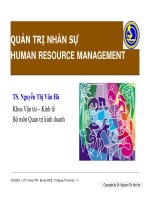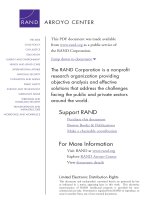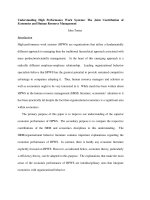HUman resource managemenr 2e s keiman chapter12
Bạn đang xem bản rút gọn của tài liệu. Xem và tải ngay bản đầy đủ của tài liệu tại đây (186.84 KB, 35 trang )
Chapter 12
Understanding Unions and
Their Impact on HRM
© 2010 Cengage Learning. Atomic Dog is a trademark used herein under license. All rights reserved.
Chapter Outline
•
12-1 Gaining Competitive Advantage
•
12-2 HRM Issues and Practices
•
12-3 The Manager’s Guide
© 2010 Cengage Learning. Atomic Dog is a trademark used herein under license. All rights reserved.
12-1a Opening Case: Gaining Competitive
Advantage at the Saturn Corporation
•
Problem: Regain lost market share in the American
Automotive industry.
•
Solution: Establish a cooperative relationship
between management and labor.
•
How cooperative relationship enhanced competitive
advantage
Promotes teamwork and encourages open communication.
Allows team members to participate in decision making.
Consensus process for decision-making.
Improved quality; enhanced interdepartmental coordination.
Better solutions through a greater flow of ideas.
© 2010 Cengage Learning. Atomic Dog is a trademark used herein under license. All rights reserved.
12-1b Linking Unions to Competitive
Advantage
•
Unions: Labor organizations in which employees
participate and which exist for the purpose of dealing
with employers concerning grievances, labor
disputes, wages, rates of pay, hours of employment,
or conditions of work.
•
Employers can contain HR-related costs by
maintaining a union-free environment.
© 2010 Cengage Learning. Atomic Dog is a trademark used herein under license. All rights reserved.
12-1b Linking Unions to Competitive
Advantage (cont.)
•
Unionized firms are often more productive than
similar nonunion companies.
•
When relations are positive between management
and the union, unionization is associated with higher
firm productivity.
•
When relations are negative, unionization is
associated with lower firm productivity.
•
Unionized firms are typically not as profitable as
similar nonunion companies.
© 2010 Cengage Learning. Atomic Dog is a trademark used herein under license. All rights reserved.
12-2a Unions Today
•
Local unions
Directly represent the interests of its members.
Members pay dues to the local for the representation it
provides.
Identify and negotiate plant issues and administer
collective bargaining agreements or contracts.
© 2010 Cengage Learning. Atomic Dog is a trademark used herein under license. All rights reserved.
12-2a Unions Today (cont.)
•
National unions
Represent workers throughout the country in a
particular craft or in a specific industry.
Negotiate major labor contracts with large employers.
Organize new local unions among unrepresented
workers.
Most local unions are chartered from parent national
unions.
Charters provide locals with professional services
offered by the national union; they also constraint the
behavior of locals.
Locals pay dues to the national union for the staff and
services it provides.
© 2010 Cengage Learning. Atomic Dog is a trademark used herein under license. All rights reserved.
12-2a Unions Today (cont.)
•
The American Federation of Labor and Congress of
Industrial Organizations (AFL-CIO)
Promotes cooperation among national unions in order
to pursue organized labor’s common objectives.
Has no power to intervene in the internal affairs of
unions.
Represents organized labor in political forums.
-
Provides lobbyists for legislative bodies.
Supports pro-union candidates for elected public office.
© 2010 Cengage Learning. Atomic Dog is a trademark used herein under license. All rights reserved.
12-2a Unions Today (cont.)
•
Union membership patterns
The percentage of employed wage and salary workers
represented by unions has reduced from 31.4 percent
in 1960 to 13 percent in 2008.
Unions continue to represent a large number of
workers in the government, manufacturing, and
transportation/public utilities industries.
© 2010 Cengage Learning. Atomic Dog is a trademark used herein under license. All rights reserved.
12-2a Unions Today (cont.)
•
Decline in union membership
Shift in employment from manufacturing to service
occupations.
Employers generally oppose unions and have always
taken an aggressive stance against them.
Employers find permanent replacements for striking
employees.
© 2010 Cengage Learning. Atomic Dog is a trademark used herein under license. All rights reserved.
12-2b Labor Law
•
Early judicial decisions
•
Allowed employers to issue yellow-dog contracts,
workers’ promises that they would not organize,
support, or join a union if the company hired them.
Key legislative actions pertaining to unions:
The Railway Labor Act
The Norris-LaGuardia Act
The National Labor Relations Act (Wagner Act)
Labor-Management Relations Act (Taft-Hartley Act)
Labor-Management Reporting and Disclosure Act
(Landrum-Griffin Act)
© 2010 Cengage Learning. Atomic Dog is a trademark used herein under license. All rights reserved.
12-2b Labor Law (cont.)
•
The Railway Labor Act
Passed in 1926.
Provides a federal guarantee of railroad employees’
rights to choose a bargaining agent.
Compelled the railroads to bargain with the employees’
representative.
Established federal machinery to resolve labor
disputes.
© 2010 Cengage Learning. Atomic Dog is a trademark used herein under license. All rights reserved.
12-2b Labor Law (cont.)
•
The Norris-LaGuardia Act
Passed in 1932.
Limits judges’ powers to issue injunctions that
restrained worker job actions.
Declared yellow-dog contracts unlawful.
© 2010 Cengage Learning. Atomic Dog is a trademark used herein under license. All rights reserved.
12-2b Labor Law (cont.)
•
The National Labor Relations Act (Wagner Act)
Passed in 1935.
Gave workers in most industries the right to form
unions and bargain collectively without being subject
to coercion by their employers.
Established the certification election process to
determine whether a majority of workers in a company
want union representation.
Created the National Labor Relations Board (NLRB) to
supervise certification elections and enforce the law.
© 2010 Cengage Learning. Atomic Dog is a trademark used herein under license. All rights reserved.
12-2b Labor Law (cont.)
•
Labor-Management Relations Act (Taft-Hartley Act)
Passed in 1947; it amended the NLRA.
Tried to restore balance of power between employers
and unions.
Made it possible for union members to rid themselves
of their union by means of a decertification election.
Gave the U.S. president the right to intervene in
national emergency strikes.
Allowed states to pass legislation outlawing “closed
shops,” companies that require union membership as
a condition of employment.
© 2010 Cengage Learning. Atomic Dog is a trademark used herein under license. All rights reserved.
12-2b Labor Law (cont.)
•
Labor-Management Reporting and Disclosure Act
(Landrum-Griffin Act)
Passed in 1959.
Regulated the internal affairs of unions.
Required unions to submit reports of all financial
expenditures to discourage officers from using union
funds for personal matters.
© 2010 Cengage Learning. Atomic Dog is a trademark used herein under license. All rights reserved.
12-2c Becoming Unionized
•
Benefits of joining a union
•
Higher salaries; better benefits.
Ability to speak one’s mind without fear of reprisal.
Better job security.
Protection against unfair treatment.
Gaining a sense of identity/unity.
Two important reasons for joining unions are job
dissatisfaction and union instrumentality.
Union instrumentality is the perceived ability of the
union to provide important benefits to the worker.
© 2010 Cengage Learning. Atomic Dog is a trademark used herein under license. All rights reserved.
Figure 12-2 A Union Organizing Campaign
© 2010 Cengage Learning. Atomic Dog is a trademark used herein under license. All rights reserved.
12-2c Becoming Unionized (cont.)
•
Petition phase
Workers express initial interest in union representation
by signing authorization cards that empower a union to
represent them in collective bargaining with the
employer.
At least 30 percent of eligible workers must sign
authorization cards for there to be a sufficient
‘‘showing of interest’’ to trigger NLRB involvement in
the certification process.
Culminates when the union asks the employer for
recognition as the bargaining representative of the
workers.
© 2010 Cengage Learning. Atomic Dog is a trademark used herein under license. All rights reserved.
12-2c Becoming Unionized (cont.)
•
Election phase
Step 1: The NLRB conducts representation hearings to
determine the appropriate bargaining unit.
-
The bargaining unit consists of those jobs or positions in
which two or more employees share common
employment interests and working conditions.
Step 2: Campaigning by both the union and the
employer.
Step 3: Election
-
Typically held on-site at the company.
The voters must be the members of the sanctioned
bargaining unit.
© 2010 Cengage Learning. Atomic Dog is a trademark used herein under license. All rights reserved.
© 2010 Cengage Learning. Atomic Dog is a trademark used herein under license. All rights reserved.
12-2c Becoming Unionized (cont.)
•
Certification phase
NLRB certifies the results.
Assuming there is no misconduct , a simple majority
by either party is required to win the election.
The employer or the union may file objections to the
election within 5 days.
If the NLRB finds evidence of gross misconduct on the
part of the employer during the campaign, it may issue
a bargaining order.
Bargaining order directs an employer to accept
collective bargaining with the union even if the
employer won the election.
© 2010 Cengage Learning. Atomic Dog is a trademark used herein under license. All rights reserved.
12-2d The Collective Bargaining
Agreement
•
Collective bargaining
Negotiations between representatives of employers
and employees to reach mutual agreement about
employment terms.
This mutual agreement is called a collective bargaining
agreement, which covers all members of the
bargaining unit, regardless of whether they are
members of the union.
Can take many forms; no one form is considered more
effective.
© 2010 Cengage Learning. Atomic Dog is a trademark used herein under license. All rights reserved.
12-2d The Collective Bargaining
Agreement (cont.)
•
Negotiating a collective bargaining agreement
Preparing for collective bargaining.
-
Information must be gathered about relevant contract
settlements.
Both parties must estimate the costs of their initial
offers.
In the case of ongoing contractual relationships, both
parties must examine their experience in attempting to
administer the current contract.
© 2010 Cengage Learning. Atomic Dog is a trademark used herein under license. All rights reserved.
12-2d The Collective Bargaining
Agreement (cont.)
Establishing a bargaining agenda: The three
categories of bargaining items are:
-
-
Illegal bargaining items: Matters about which bargaining
is not permitted by law.
Mandatory bargaining items: Issues that must be
negotiated if either party brings these matters to the
table.
Voluntary or permissive bargaining items: Become part
of the negotiations only if both parties agree to discuss
them.
© 2010 Cengage Learning. Atomic Dog is a trademark used herein under license. All rights reserved.




![audio engineering 101 [electronic resource] a beginner's guide to music production](https://media.store123doc.com/images/document/14/y/ii/medium_iij1401381447.jpg)
![broken markets [electronic resource] a user's guide to the post-finance economy](https://media.store123doc.com/images/document/14/y/kz/medium_kzd1401381668.jpg)
![ios sdk programming [electronic resource] a beginner's guide](https://media.store123doc.com/images/document/14/y/ph/medium_phw1401472929.jpg)


